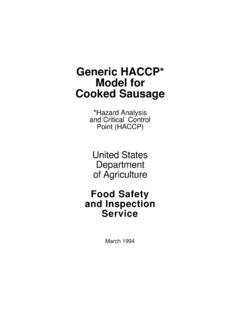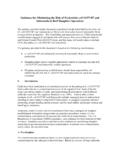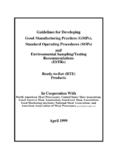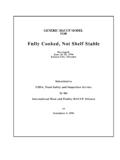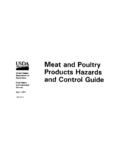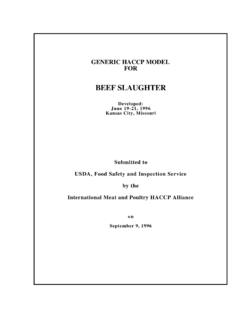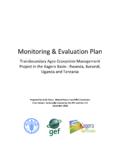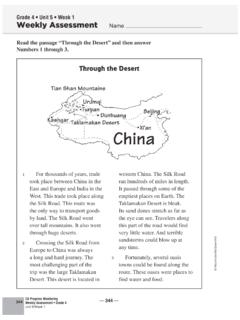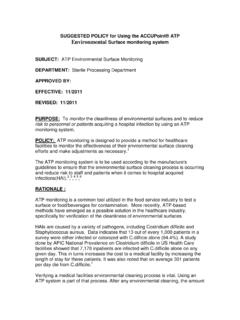Transcription of HAZARD ANALYSIS AND CRITICAL CONTROL …
1 1 HAZARD ANALYSIS AND CRITICAL CONTROL POINTPRINCIPLES AND APPLICATION GUIDELINESADOPTEDA ugust 14, 1997 NATIONAL ADVISORY COMMITTEE ON MICROBIOLOGICAL CRITERIA FOR FOODS2 TABLE OF CONTENTSEXECUTIVE 6 HACCP 8 GUIDELINES FOR APPLICATION OF HACCP 9 Prerequisite 9 Education and 10 Developing a HACCP 10 Assemble the HACCP 11 Describe the food and its 12 Describe the intended use and consumers of the 12 Develop a flow diagram which describes the 12 Verify the flow 12 Conduct a HAZARD ANALYSIS (Principle 1).. 12 Determine CRITICAL CONTROL points (CCPs) (Principle 2).. 15 Establish CRITICAL limits (Principle 3).. 16 Establish monitoring procedures (Principle 4).. 17 Establish corrective actions (Principle 5).. 18 Establish verification procedures (Principle 6).. 19 Establish record-keeping and documentation procedures (Principle 7).. 213 TABLE OF CONTENTS - CONTINUEDIMPLEMENTATION AND MAINTENANCE OF THE HACCP 21 APPENDIX A - Examples of common prerequisite 23 APPENDIX B - Example of a flow diagram for the production of frozen cooked beef 25 APPENDIX C - Examples of questions to be considered when conducting a HAZARD 26 APPENDIX D - Examples of how the stages of HAZARD ANALYSIS are used to identify and evaluate 30 APPENDIX E - Example I of a CCP decision 31 APPENDIX F - Example II of a CCP decision 32 APPENDIX G - Examples of verification 33 APPENDIX H - Examples of HACCP 354 EXECUTIVE SUMMARYThe National Advisory Committee on Microbiological Criteria for Foods (Committee)reconvened a HAZARD ANALYSIS and CRITICAL CONTROL Point (HACCP) Working Group in 1995.
2 Theprimary goal was to review the Committee s November 1992 HACCP document, comparing it tocurrent HACCP guidance prepared by the Codex Committee on Food Hygiene. Based upon itsreview, the Committee made the HACCP principles more concise; revised and added definitions;included sections on prerequisite programs, education and training, and implementation andmaintenance of the HACCP plan; revised and provided a more detailed explanation of theapplication of HACCP principles; and provided an additional decision tree for identifying criticalcontrol points (CCPs).The Committee again endorses HACCP as an effective and rational means of assuring food safetyfrom harvest to consumption. Preventing problems from occurring is the paramount goalunderlying any HACCP system. Seven basic principles are employed in the development ofHACCP plans that meet the stated goal. These principles include HAZARD ANALYSIS , CCPidentification, establishing CRITICAL limits, monitoring procedures, corrective actions, verificationprocedures, and record-keeping and documentation.
3 Under such systems, if a deviation occursindicating that CONTROL has been lost, the deviation is detected and appropriate steps are taken toreestablish CONTROL in a timely manner to assure that potentially hazardous products do not reachthe consumer. In the application of HACCP, the use of microbiological testing is seldom an effective means ofmonitoring CCPs because of the time required to obtain results. In most instances, monitoring ofCCPs can best be accomplished through the use of physical and chemical tests, and through visualobservations. Microbiological criteria do, however, play a role in verifying that the overallHACCP system is Committee believes that the HACCP principles should be standardized to provide uniformityin training and applying the HACCP system by industry and government. In accordance with theNational Academy of Sciences recommendation, the HACCP system must be developed by eachfood establishment and tailored to its individual product, processing and distribution keeping with the Committee s charge to provide recommendations to its sponsoring agenciesregarding microbiological food safety issues, this document focuses on this area.
4 The Committeerecognizes that in order to assure food safety, properly designed HACCP systems must alsoconsider chemical and physical hazards in addition to other biological a successful HACCP program to be properly implemented, management must be committedto a HACCP approach. A commitment by management will indicate an awareness of the benefits5and costs of HACCP and include education and training of employees. Benefits, in addition toenhanced assurance of food safety, are better use of resources and timely response to Committee designed this document to guide the food industry and advise its sponsoringagencies in the implementation of HACCP Decision Tree: A sequence of questions to assist in determining whether a CONTROL point is : (a) To manage the conditions of an operation to maintain compliance with establishedcriteria. (b) The state where correct procedures are being followed and criteria are being Measure: Any action or activity that can be used to prevent, eliminate or reduce asignificant Point: Any step at which biological, chemical, or physical factors can be Action: Procedures followed when a deviation : A requirement on which a judgement or decision can be CONTROL Point: A step at which CONTROL can be applied and is essential to prevent oreliminate a food safety HAZARD or reduce it to an acceptable Limit: A maximum and/or minimum value to which a biological, chemical or physicalparameter must be controlled at a CCP to prevent, eliminate or reduce to an acceptable level theoccurrence of a food safety : Failure to meet a CRITICAL : A systematic approach to the identification, evaluation, and CONTROL of food Plan.
5 The written document which is based upon the principles of HACCP and whichdelineates the procedures to be System: The result of the implementation of the HACCP Team: The group of people who are responsible for developing, implementing andmaintaining the HACCP : A biological, chemical, or physical agent that is reasonably likely to cause illness orinjury in the absence of its ANALYSIS : The process of collecting and evaluating information on hazards associated withthe food under consideration to decide which are significant and must be addressed in the : To conduct a planned sequence of observations or measurements to assess whether aCCP is under CONTROL and to produce an accurate record for future use in Programs: Procedures, including Good Manufacturing Practices, that addressoperational conditions providing the foundation for the HACCP : The seriousness of the effect(s) of a : A point, procedure, operation or stage in the food system from primary production to : That element of verification focused on collecting and evaluating scientific andtechnical information to determine if the HACCP plan, when properly implemented, willeffectively CONTROL the : Those activities, other than monitoring, that determine the validity of the HACCP plan and that the system is operating according to the HACCP PRINCIPLESHACCP is a systematic approach to the identification, evaluation, and CONTROL of food safetyhazards based on the following seven principles:Principle 1: Conduct a HAZARD 2: Determine the CRITICAL CONTROL points (CCPs).
6 Principle 3: Establish CRITICAL 4: Establish monitoring 5: Establish corrective 6: Establish verification 7: Establish record-keeping and documentation FOR APPLICATION OF HACCP PRINCIPLESI ntroductionHACCP is a management system in which food safety is addressed through the ANALYSIS andcontrol of biological, chemical, and physical hazards from raw material production, procurementand handling, to manufacturing, distribution and consumption of the finished product. Forsuccessful implementation of a HACCP plan, management must be strongly committed to theHACCP concept. A firm commitment to HACCP by top management provides companyemployees with a sense of the importance of producing safe is designed for use in all segments of the food industry from growing, harvesting,processing, manufacturing, distributing, and merchandising to preparing food for consumption. Prerequisite programs such as current Good Manufacturing Practices (cGMPs) are an essentialfoundation for the development and implementation of successful HACCP plans.
7 Food safetysystems based on the HACCP principles have been successfully applied in food processing plants,retail food stores, and food service operations. The seven principles of HACCP have beenuniversally accepted by government agencies, trade associations and the food industry around following guidelines will facilitate the development and implementation of effective HACCP plans. While the specific application of HACCP to manufacturing facilities is emphasized here,these guidelines should be applied as appropriate to each segment of the food industry ProgramsThe production of safe food products requires that the HACCP system be built upon a solidfoundation of prerequisite programs. Examples of common prerequisite programs are listed inAppendix A. Each segment of the food industry must provide the conditions necessary to protectfood while it is under their CONTROL . This has traditionally been accomplished through theapplication of cGMPs.
8 These conditions and practices are now considered to be prerequisite tothe development and implementation of effective HACCP plans. Prerequisite programs providethe basic environmental and operating conditions that are necessary for the production of safe,wholesome food. Many of the conditions and practices are specified in federal, state and localregulations and guidelines ( , cGMPs and Food Code). The Codex Alimentarius GeneralPrinciples of Food Hygiene describe the basic conditions and practices expected for foodsintended for international trade. In addition to the requirements specified in regulations, industryoften adopts policies and procedures that are specific to their operations. Many of these areproprietary. While prerequisite programs may impact upon the safety of a food, they also areconcerned with ensuring that foods are wholesome and suitable for consumption (Appendix A).
9 HACCP plans are narrower in scope, being limited to ensuring food is safe to existence and effectiveness of prerequisite programs should be assessed during the design andimplementation of each HACCP plan. All prerequisite programs should be documented andregularly audited. Prerequisite programs are established and managed separately from theHACCP plan. Certain aspects, however, of a prerequisite program may be incorporated into aHACCP plan. For example, many establishments have preventive maintenance procedures forprocessing equipment to avoid unexpected equipment failure and loss of production. During thedevelopment of a HACCP plan, the HACCP team may decide that the routine maintenance andcalibration of an oven should be included in the plan as an activity of verification. This wouldfurther ensure that all the food in the oven is cooked to the minimum internal temperature that isnecessary for food and TrainingThe success of a HACCP system depends on educating and training management and employeesin the importance of their role in producing safe foods.
10 This should also include information thecontrol of foodborne hazards related to all stages of the food chain. It is important to recognizethat employees must first understand what HACCP is and then learn the skills necessary to makeit function properly. Specific training activities should include working instructions andprocedures that outline the tasks of employees monitoring each must provide adequate time for thorough education and training. Personnel must begiven the materials and equipment necessary to perform these tasks. Effective training is animportant prerequisite to successful implementation of a HACCP a HACCP PlanThe format of HACCP plans will vary. In many cases the plans will be product and processspecific. However, some plans may use a unit operations approach. Generic HACCP plans canserve as useful guides in the development of process and product HACCP plans; however, it isessential that the unique conditions within each facility be considered during the development ofall components of the HACCP the development of a HACCP plan, five preliminary tasks need to be accomplished before theapplication of the HACCP principles to a specific product and process.
